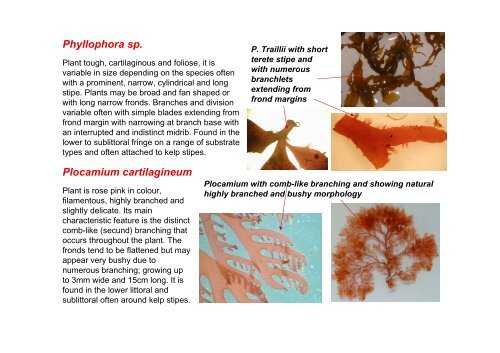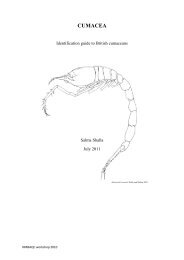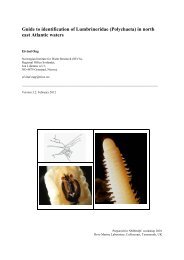s A Field Guide to the British Seaweeds - NMBAQC
s A Field Guide to the British Seaweeds - NMBAQC
s A Field Guide to the British Seaweeds - NMBAQC
Create successful ePaper yourself
Turn your PDF publications into a flip-book with our unique Google optimized e-Paper software.
Phyllophora sp.<br />
Plant <strong>to</strong>ugh, cartilaginous and foliose, it is<br />
variable in size depending on <strong>the</strong> species often<br />
with a prominent, narrow, cylindrical and long<br />
stipe. Plants may be broad and fan shaped or<br />
with long narrow fronds. Branches and division<br />
variable often with simple blades extending from<br />
frond margin with narrowing at branch base with<br />
an interrupted and indistinct midrib. Found in <strong>the</strong><br />
lower <strong>to</strong> sublit<strong>to</strong>ral fringe on a range of substrate<br />
types and often attached <strong>to</strong> kelp stipes.<br />
Plocamium cartilagineum<br />
Plant is rose pink in colour,<br />
filamen<strong>to</strong>us, highly branched and<br />
slightly delicate. Its main<br />
characteristic feature is <strong>the</strong> distinct<br />
comb-like (secund) branching that<br />
occurs throughout <strong>the</strong> plant. The<br />
fronds tend <strong>to</strong> be flattened but may<br />
appear very bushy due <strong>to</strong><br />
numerous branching; growing up<br />
<strong>to</strong> 3mm wide and 15cm long. It is<br />
found in <strong>the</strong> lower lit<strong>to</strong>ral and<br />
sublit<strong>to</strong>ral often around kelp stipes.<br />
P. Traillii with short<br />
terete stipe and<br />
with numerous<br />
branchlets<br />
extending from<br />
frond margins<br />
Plocamium with comb-like branching and showing natural<br />
highly branched and bushy morphology




